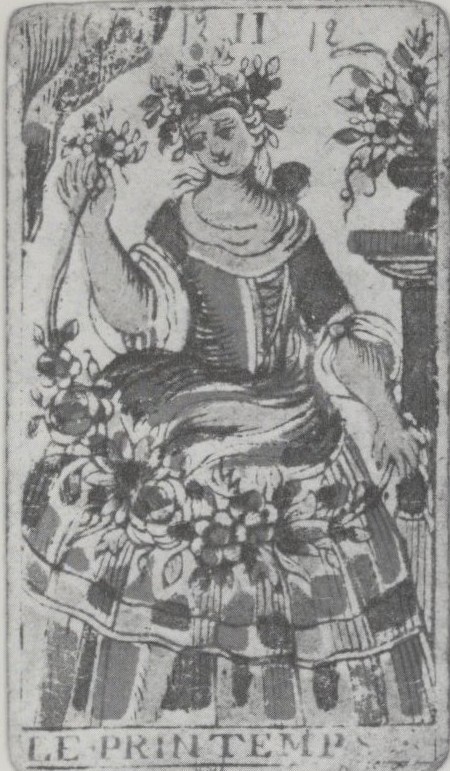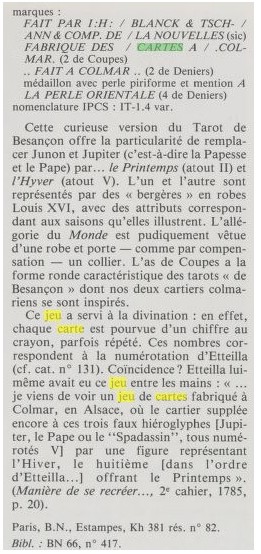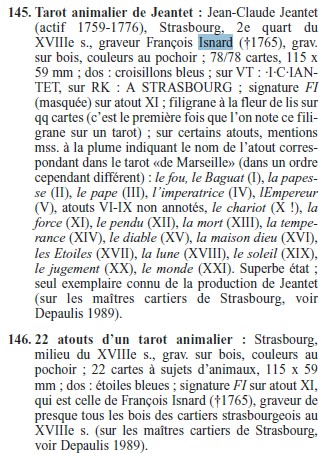********************
Starting point:
Thierry Depaulis wrote in 2010 an article "When (and how) Tarot reached Germany" (IPSC 39/2, starting p. 64). The article is excellent, it helps here to develop a basic line of German/Austrian Tarock development.
As German language forms Depaulis identifies Taroc, Tarok, Daroque, Darock, Tarroque etc. No occurrence of these words is known in Germany before 1752 (says Depaulis) ... Depaulis refers to Sigmar Radau, "Tiertarock" (1989), who had listed some playing card tax laws and some other research.
Meanwhile there are many own findings, between them also the oldest Tarock in a German language printed work in 1750/51.
******************
1687: A cardmaker Antoine Joly, originally born in Lyons, who had worked in Montbeliard (earlier Mömpelgard) arrived 6 years after the French occupation of Strassburg (so 1687 ?) in Strassburg. Then, so says Depaulis, no cardmaker had been in the town or a longer time. "There is no evidence of any cardmaker in other places [in Alsace], even in Colmar, before the mid 18th century."
More: viewtopic.php?f=11&t=821&p=11900&hilit= ... eis#p11900
Since 1707: Louis de Laboisse (from Paris) since 1707, Pierre Lachapelle (from Lyons) (1714-44), David Benoist (1717-1761) appear as cardmakers in Strassburg. Depaulis declared, that in this development Tarot decks with so-called Besancon-style, appeared.
"Indeed we have at least one pack from each of the aforementioned masters .... They are all, save one, of the 'Besancon' variant of the Tarot de Marseille, with Juno and Jupiter. The one exception is a Tarot pack made by Louis de Laboisse, 'A la la Perle Orientale', where the two problematic cards ... have been replaced by 'Le Printemps' and 'L'Hyver'".
Depaulis suggests, that the decks called "Tarot de Besancon" actually are Tarots from Strasbourg. He suggests a dating for the deck with "Le Printemps' and 'L'Hyver' instead of Pope and Popess of c. 1710.
More: viewtopic.php?f=11&t=821&p=11900&hilit= ... eis#p11900
Added later: Depaulis had described a similar deck in "Tarot, jeu et magie : [exposition], Bibliothèque nationale, [Paris, 17 octobre] 1984-[6 janvier 1985] / [catalogue par Thierry Depaulis] -Bibliothèque nationale (Paris)-1984" [ http://gallica.bnf.fr/ark:/12148/bpt6k6 ... ate.langEN ]
The deck was then estimated to be produced c. 1780 ...
"L'Hyver" (= Winter) ... replacement for Pope
"Printemps" (= Spring) ... replacement for Popess
produced by Black and Tschann in Colmar
1713: Francois Isnard (engraver) arrives in Strasbourg.
The engraver sign of this possibly earliest deck with Pope-Popess changes signs with "J.N." - different to "F.I.", which stands for Francois Isnard, who is called by Depaulis ... well, Depaulis himself explains it better:

1720-35: Radau takes the SEBASTIAN IOIA deck in Besancon style (Kaplan II, p. 324) as from 1720/25. IN VERLAG BEY SEBASTIAN HEINRICH IOIA IN AUGSPURG WUNHAFFT BEY DER SCHWAHL MYHL. Depaulis notes, that Sebastian Heinrich Joja is documented from 1720-33, referring to S. Radau & G. Matthes, Deutsche Spielkarten 1650-1900, Nuremberg, GNM, 2001, no. 18.
Kaplan has the cardmaker Sebastian IOIA as active from 1720 - 1785 (father and son ?).
1720-1750: Pelagius Mayer was born in Kempten - in contrast to earlier ideas - in 1690 and was active since 1720 in Constance. According Kaplan II p. 320 the latest documentary evidence of him is from 1737. The deck is at Kaplan II p. 325, again in Besancon style.
1729-1762: Franco Pratesi detected 2013 a resource about the export of Minchiate decks from Tuscany to other countries. Some of the decks went to "Northern countries".
http://trionfi.com/evx-minchiate-export-tuscany
1735 or later: Radau takes a deck of Johann Wolfgang Weber, Ulm, Besancon style, as from c. 1735. TAROS FIN DE IEAN WOLFGANG WEBER A VLME. Depaulis notes, that the cardmaker was active from c. 1735 - 1787, so the relevant deck might be of a much later time.German Empire
Vienna 1720/24 1731/4 1748/33 1749/24 1752/6 1756/144 1761/48 (totally 238)
Colonia 1731/40 1761/12 (totally 52)
Germania 1747/34 (totally 34)
Dresda 1741/12 (totally 12)
France
Marsilia 1732/48 (totally 48)
Francia 1760/24 (totally 24)
Parigi 1734/12 (totally 12)
England
Londra 1753/4 (totally 4)
totally 424 for all mentioned
For comparison:
Genova, a city with some documented interest for Minchiate had totally 656 between 1732-1751. Most exports went to Roma - 45140. Totally 62517 Minchiate decks were exported from Toscana in c. 33 years.
A family painting with Tarock scene, treated in "D. Strehl: Spielerische Bemerkungen zur Tarockrunde auf dem Ahnenbild der Familie von Zobel aus 1735 bis 1750." [This is probably the family "von Zobel in Giebelstadt"]
From Heft 6, (1992) on this list: http://www.spielkartensammler.de/bdk/das-blatt.html
The same painting is mentioned by Depaulis, but he doesn't repeat the dating.
1739: likely TITLE ERROR (?); books.google.com offers this book
https://books.google.de/books?id=8wFeAA ... navlinks_s"Palamedes redivivus, das ist: nothwendiger Unterricht, wie heutiges Tages gebräuchliche Spiele, als das Stein- oder Schach-Spiel, das Picquet-Hoick-Thurn-und L'ombre-Spiel ... nach künstlicher Wissenschafft recht und wohl zu spielen, aus denen übgründlichen Spiel-Gesetzen herfür gesucht, und ausführlich beschrieben; auch bey dieser neuen Auflage abermahl vermehrt mit dem Trifett-und Taroc-Spiel
A. Martini, 1739
The content "Taroc-Spiei" could't be confirmed.
1746: Baierische Kriegs-Artikel 1746 (prohibition) in text of 1771
http://books.google.de/books?id=tqpDAAA ... &q&f=false
1748: End of the Austrian Succession war 1740-48
It seems rather obvious, that this war and the following "Peace of Aachen" in October 1748 caused the rapid and explosive distribution of the Tarock game in the following years. A key element of the quick distribution might have been the installment of Swiss Guards at the courts of Austria and in Holland after the war (Tarock had been well installed in Switzerland long before).
viewtopic.php?f=11&t=821&p=11699&hilit= ... rds#p11699
Another factor might have been the installment of scientific societies, the general use of coffee-houses and the increasing German interests in theater-plays.
The development of Cartomancy in Germany followed soon (known first in 1763) in this generally developing society.
http://trionfi.eu/village/viewtopic.php?f=21&t=1390
1748: A. B. Göbl in Munich opens his card producer shop and produces Tarot cards (the begin is not clear). Depaulis suggests, that this is possibly that, what in Bavaria this is addressed as "Welsches Tarock".
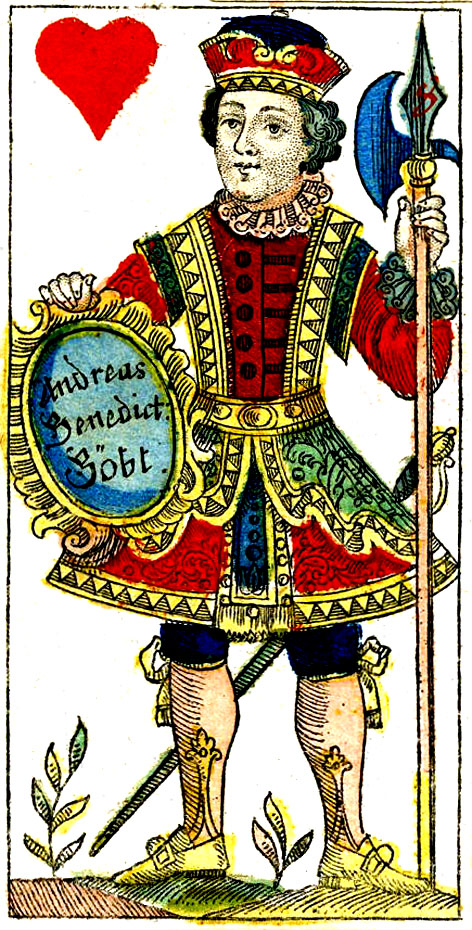

1750: FEINE TAROS BEY FERDINAND SCHOBER IN NEUHAUS 1750 ... Kaplan II didn't note this deck. Depaulis seems to know it: He calls it a "curious mixed Tarot / Trappola pack" and he identifies Neuhaus as Jindfichuv Hradec in the Czech republic (South of Prague). Depaulis notes, that this is momentary the oldest date for Taros (or similar) in Germany.
Deck at British Museum: https://www.britishmuseum.org/research/ ... more-views
1750: Mümliswil - Switzerland. Rochus I Schaer (1696 - 1773), Tarot deck (Marseilles type; Kaplan II p. 326/327)
1751: Own finding:
Anakreontische Versuche, Volume 1
Johann Franz von Palthen
printed by Weitbrecht


Johann Franz von Palthen (1724 - 1804) - worldcat has a lot of publications, but I don't found a good biography.
http://www.worldcat.org/search?q=au%3AJ ... ort_yr_asc
Worldcat offers the text partly as of 1750, books.google.com has it from 1751. The publication location is Stralsund, the author also published in Rostock. He is mentioned in a short biography of his father: http://de.wikipedia.org/wiki/Jakob_Palthen ... "Ihr Sohn Johann Franz (1725–1804) wurde Advokatfiskal am Wismarer Tribunal."
The text:
http://books.google.de/books?id=xAdOAAA ... ck&f=false
1751: Own finding:
Auszug der neuesten Weltgeschichte : auf das Jahr ... ; 1751
Autor / Hrsg.: Groß, Johann Gottfried
Verlagsort: Erlangen ; Nürnberg
Signatur: Eph.pol. 28-1751
http://bavarica.digitale-sammlungen.de/ ... flC=person

1752: Sigmar Radau has found two playing card tax tariffs published in 1752. The first is from Saxony Altenburg (small duchy South of Leipzig) ..
http://en.wikipedia.org/wiki/File:Map-saxony1900.png
... and notes"Ein Stück Taroc-Charten 4 Gr."
The second is from Bavaria Juli 1752, which used "Daroquen" (an earlier law of 1745 didn't use it).
Radau found another note from the same year: The Augsburger paper-maker Chr. A. Harz sent special paper for the production of Tarock cards to A.B.Göbl in Munich.
1754-56: Thierry Depaulis refers to book productions, about which I recently worked about:
forum.tarothistory.com/viewtopic.php?f=11&t=622&start=14
Depaulis notes, that an earlier edition (1749) didn't contain the Tarot rules
Around 1755: Johann Rauchmiller in Salzburg produced Tarock cards around this time. A price list of the producer in 1738 hadn't Tarock cards.
From Heft 7, first article on this list: http://www.spielkartensammler.de/bdk/das-blatt.html
1755:
Auszug der neuesten Weltgeschichte und schönen Wissenschaften ; 1755
Verlagsort: Erlangen | Erscheinungsjahr: 1755 | Verlag: Groß
Signatur: Eph.pol. 28-1755
http://bavarica.digitale-sammlungen.de/ ... flC=person

http://books.google.de/books?id=ZK1LAAA ... ck&f=false
[in this context is mentioned Christoph Friedrich Nicolai (1733-1811) ...
http://en.wikipedia.org/wiki/Christoph_ ... ch_Nicolai
... a friend of Lessing, who is mentioned in the following documents variously.He appears as an author of an longer essay of roughly 50 pages about the origin of playing cards more than 50 years later in 1808 ...
Nicolai, F. : Einige Bemerkungen über das Tarockspiel, und über die erste Erfindung des Kartenspiels überhaupt.
In: Berlinische Monatschrift. 1783-1811. 1808 , S. 65 - 106
http://www.ub.uni-bielefeld.de/diglib/a ... /suche.htm
search for "Tarockspiel"]
1756
Auszug der neuesten Weltgeschichte und schönen Wissenschaften ; 1756
Verlagsort: Erlangen | Erscheinungsjahr: 1756 | Verlag: Groß
Signatur: Eph.pol. 28-1756
http://bavarica.digitale-sammlungen.de/ ... flC=person

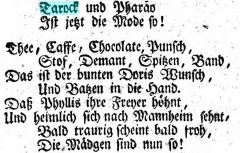
Auszug der neuesten Weltgeschichte und schönen Wissenschaften ; 1756
Verlagsort: Erlangen | Erscheinungsjahr: 1756 | Verlag: Groß
Signatur: Eph.pol. 28-1756
http://bavarica.digitale-sammlungen.de/ ... flC=person

1758: Bürgerliche rechtsgelehrsamkeit der Teutschen:
nach maasgebung der Reichs-abschiede und bewährter nachrichten auch der regirungs- sodann rechts- und policei- anbenebst der kammer- imgleichen der stadt- und landwirtschafts-kunden. Der Teutschen rechtsgelahrtheit andrer teil, Volume 2
Johann Georg Estor, Johann A. Hofmann
Weldige, 1758 - 1132 pages
in Book III, Chapter 20 "von spilen"
http://books.google.de/books?id=G2NDAAA ... oc&f=false
1759 June 22: an Austrian "Patent" lists "Frantzösische- oder Piquet-, Tarock und grosse Traplier-Carthen". A previous edict in 1750 didn't note Tarock. (Depaulis)
1759 Pupils of Jesuits in Innsbruck give a theater play "Mundus ludens in tarockorum lusu adumbratus", a syntaxi minore oenipontana (in Innsbruck dialect) (Depaulis)
viewtopic.php?t=345&p=22409#p22409
1759 A French text refers to a joke, which Abraham Gotthelf ...
http://en.wikipedia.org/wiki/Abraham_Go ... C3%A4stner
... used in his texts about the basic of arithmetik, which demands in his opinion not more attention, "als ein Frauenzimmer braucht das Taroc spielet"
http://books.google.de/books?id=3WkEAAA ... oc&f=false
1760: Natürliches Zauber-Buch, oder neu-eröfneter Spielplatz rarer Künste:
Mit vielen Figuren erl, Volume 2
Schwarzkopf, 1760 - 526 pages
[includes Taroc-rules, which at least in great parts are copied from earlier works ... and other game rules]
http://books.google.de/books?id=i7g5AAA ... &q&f=false
1761: Primae Lineae Bibliothecae lusoriae
Heinrich Jonathan Clodius
http://books.google.de/books?id=PaZAAAA ... oc&f=false
1761: One-act comedy by Karl Franz Romanus: "Das Tarocspiel", printed in Dresden and Warsaw.
http://books.google.de/books?id=BaBQAAA ... en&f=false
1761 or little later: in 1759-63 letters (published 1765): Briefe, die neueste Litteratur betreffend:
Geschrieben in den Jahren 1759 bis 1763. Vier und zwanzig Theile nebst doppelten Registern, Volumes 21-24
Friedrich Nicolai, Gotthold Ephraim Lessing, Moses Mendelssohn, Friedrich Grillo, Thomas Abbt, Friedrich Gabriel Resewitz
collected by F. Nicolai, 1765
(Critique on a theater play, which used Tarock; the not named theater play is that of Karl Franz Romanus 1761)
http://books.google.de/books?id=pnoHAAA ... oc&f=false

1763: Book announcement
Augspurgische Ordinari-Post-Zeitung ; 1763
Verlagsort: [Augsburg]
Signatur: 4 Eph.pol. 53-1763
http://bavarica.digitale-sammlungen.de/ ... flC=person

Duhamel du Monceau (M.), Johann Heinrich Gottlob von Justi [translator]
Bey J.H. Rüdigern, 1764 - 40 pages
http://books.google.de/books?id=UXQOAAA ... navlinks_s
"Taraux" is mentioned at page 4.
The author uses "Würfel" (dice) for Carreaux, "Kleeblatt" for Trèfle, "Schüppen" for Pique and the usual "Herzen" for hearts.
1765: Petrasch publishes a comedy "Das Eiland der Bucklichten" (page 161)
http://books.google.de/books?id=R-c6AAA ... navlinks_s
One role has the name Tarofolo.
1767: Petrasch publishes a Tarock poem. The observed deck is Besancon Tarot. See:
viewtopic.php?f=11&t=819
May 1769: A similar play as that of 1759 by pupils in Salzburg, in Salzburger dialect. (Depaulis)
1769: Der Geburtstag: ein Lustpiel (Comedy)
Franz von Heufeld
http://books.google.de/books?id=qCQ7AAA ... ck&f=false
1769: Intelligenz-Blatt der freien Stadt Frankfurt
[A Frankfurt merchant offers Taroc cards from Brussels]
http://books.google.de/books?id=8ixRAAA ... oc&f=false
1769: Description Des Villes De Berlin Et De Potsdam Et De Tout Ce Qu'Elles Contiennent De Plus Remarquable:
Traduit De L'Allemand (Google eBook)
Friedrich Nicolai
Nicolai, 1769 - 622 pages
http://books.google.de/books?id=lNwAAAA ... oc&f=false
1769/70: Critique at a new edition (1769) of a rules book from 1756 in:
Allgemeine deutsche Bibliothek, Volume 11
by Friedrich Nicolai (1770)
http://books.google.de/books?id=xmQvAAA ... oc&f=false
1770: Das Neue königliche l'hombre, auch wie quadrille, cinquille, piquet, trisett, taroc etc. nach jetziger art zu spielen: wobey nebst noch andern kartenspielen das billard, pielkentafel, schach und ball spiel, etc. genau beschrieben und sorg fältig erkläret werden
in der Heroldischen buchhandlung, 1770
http://books.google.de/books?id=i0oVAAA ... navlinks_s
1770: "Das La Fontaine-Tarock des Leipziger Kaufmanns Peter Friedrich Ulrich. Faksimile-Nachdruck eines Tier-Tarockspiel von 1770 aus dem Besitz von Erwin Kohlmann, Naumburg."
http://www.spielkartenladen.de/product_ ... arock.html
http://www.tarotcollectors.com/view_top ... forum_id=4
1770: Sammlung der neuest und merkwürdigsten churbaierischen generalien und landesverordnungen ...
Bavaria (Germany).
J.N. Fritz, 1771 - Law - 596 pages
"Mandat von Anno 1770 den Kartenstempel betreffend"
books.google.de/books?id=tqpDAAAAcAAJ&pg=PA228&lpg=PA229&dq=kartenmacher+göbl&source=bl&ots=bvzBjJE0SU&sig=xHCiSOTQnxxvn7u4l7VfsMNX4dg&hl=en&sa=X&ei=fQ2kT-3cG8rg4QSBno2pCQ&redir_esc=y#v=onepage&q=kartenmacher göbl&f=false
**********************************************
Further passages of minor value:
1759, Dresden, announcement of Tarock rules
http://books.google.de/books?id=2rBAAAA ... oc&f=false
1760, Eisenach
http://books.google.de/books?id=O846AAA ... ck&f=false
1761, Erlangen
http://books.google.de/books?id=nAJEAAA ... ck&f=false
1763, Erlangen
http://books.google.de/books?id=hMZFAAA ... oc&f=false
1763, Wordbook
http://books.google.de/books?id=nAJEAAA ... ck&f=false
1765 Hannover
http://books.google.de/books?id=G0JEAAA ... ck&f=false
1765 Bavaria
http://books.google.de/books?id=LNlIAAA ... ck&f=false
1765 Bavaria
http://books.google.de/books?id=Q59QAAA ... oc&f=false
1766
http://books.google.de/books?id=qbFGAAA ... ck&f=false
1767 letter, Halberstadt
http://books.google.de/books?id=nWEHAAA ... oc&f=false
1767
http://books.google.de/books?id=ivRCAAA ... oc&f=false
1770, Comedy
http://books.google.de/books?id=nAJEAAA ... ck&f=false


